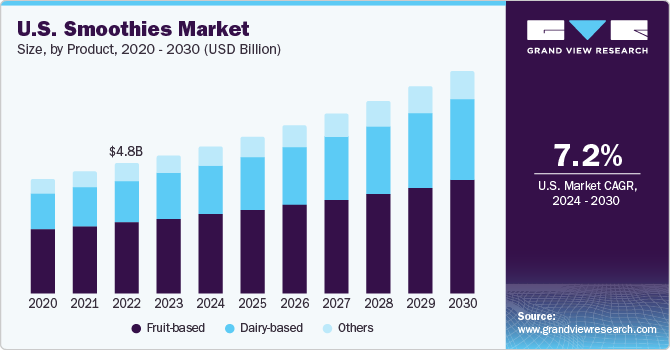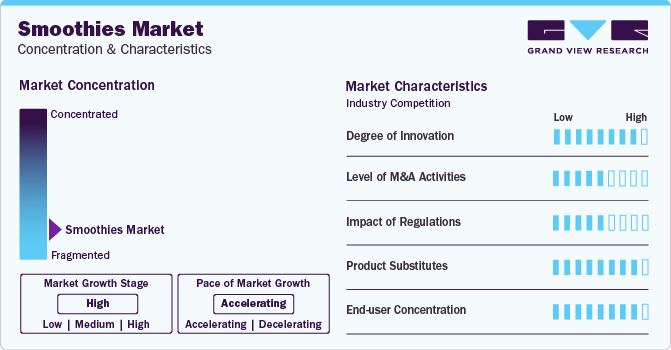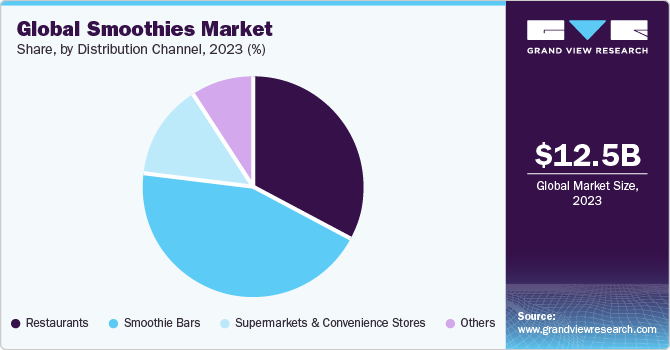The smoothie industry is booming. The global smoothies market is projected to grow at a compound annual growth rate (CAGR) of 8.5% from 2024-2031. With consumers becoming more health-conscious, smoothies make for an appealing business opportunity right now.

In this comprehensive guide, we’ll walk you through how to start a smoothie business. You’ll learn insider tips on sourcing equipment, marketing, registering an EIN, obtaining business insurance, and more.
1. Conduct Smoothie Market Research
The smoothie industry has exploded in recent years as health consciousness rises. Analyzing the market opportunity requires researching smoothie industry growth forecasts, consumer demographics and preferences, optimal store locations, profit margins, and more.

Market share is currently dominated by big brands like Jamba Juice and Smoothie King. This leaves ample room for smaller independent shops to carve out a customer base with the right positioning.
When scouting locations, pay attention to metro areas with high concentrations of health-conscious millennial and Gen Z consumers. Foot traffic and visibility are also key variables. Some smoothie businesses are even investing in a food truck to make blended fruit drinks mobile.
Food allergy prevalence is rising among U.S. adults. Having clearly labeled allergen-friendly options can better accommodate this group. When it comes to flavor preferences, aim for mixed berries, strawberry bananas, and tropical fruit. Offering creative specialty options beyond the staples can help differentiate your smoothie shop.
Initial equipment and opening costs typically range from $75,000-$250,000. Exact costs vary widely depending on size, location, and equipment selections. Leasing spaces visible to high foot traffic areas often demand higher rent but offer more sales potential.
Thorough market research of industry forecasts, target demographics, consumer preferences, ideal locations, startup costs, and profit scenarios will all inform the strategy for launching and positioning a successful smoothie shop. Analyzing granular data and trends is time well spent early on to determine viable business opportunities.
2. Analyze the Competition
Carefully scoping out the competitive landscape is critical when launching any small business, smoothie shops included. This competitive analysis should evaluate both local brick-and-mortar competitors as well as assess broader market competition online.

To analyze nearby competitor smoothie bars, start by identifying existing shops in the immediate area surrounding your proposed location. Walk through each establishment and evaluate factors like their menu options, recipe innovation, price points, store ambiance, and speed of service.
Additionally, observe their peak customer flows. Well-run small businesses often experience a morning rush from 9-11 am as people stop in for a nutrient-boosting post-workout drink. Competitors near offices may also see an influx of professionals place mid-day orders. Getting a pulse on high-demand ordering times allows you to staff appropriately to keep up with the lunchtime rush.
When it comes to online competition, search for highly-rated smoothie shops in your city on platforms like Yelp, Google, and Facebook and scroll through reviews. This offers insights into what customers in your area are looking for, along with potential gaps your smoothie menu could fill.
Pay attention to how competitors actively manage their online reputation by responding to customer feedback and feature updates on seasonal menu launches. This level of engagement is now table stakes for brick-and-mortar food establishments.
Likewise, investigate the eCommerce capabilities your competitor smoothie bars have invested in. From online ordering systems for mobile order pick-ups to delivery service partnerships, these digital avenues have become necessary, especially post-pandemic.
By benchmarking nearby players as well as analyzing broader eCommerce capabilities, smoothie entrepreneurs can craft competitive differentiation strategies. The key is identifying potential gaps in the market when it comes to production values, menu variety, ordering convenience, and overall customer service.
3. Costs to Start a Smoothie Business
Starting a juice and smoothie bar requires some initial investment. A successful smoothie business will also incur ongoing charges to stay up and running. As you develop your business plan, be sure to format a realistic budget. Here’s an overview of some of the costs you’ll encounter as a drink and food business.
Start-up Costs
- Development costs vary widely based on size and scale but expect to spend $75,000-$250,000 to launch a compact smoothie bar.
- Starting with required legal and admin expenses, officially registering your business as an LLC will run roughly $500 when incorporating paperwork fees, licenses, and basic liability insurance.
- Completing the proper health department paperwork, inspections and permits to sell fresh blended drinks will add another $1,000 in compliance costs as well.
- Leasing even a compact 400-600 sq ft standalone storefront in an ideal spot could start around $4,000 per month. This equals $48,000/year assuming a triple-net lease.
- Expect another $20,000-$75,000 to account for basic flooring, lighting fixtures, counters with barstool seating, and a welcoming paint job.
- A commercial-grade blender like a Vitamix 36019 can produce consistent batches for $449 each.
- Most compact shops require 2-4 units plus backups given their continual use, putting essential blender costs around $2,000.
- Add in $3,000-5,000 for a commercial refrigerator/freezer combo unit plus another $1,500 for a fruit/veggie prep table setup.
- Smallwares like cups, blenders, straws, and serving equipment will be another $500. With misc costs, plan on $10,000 to outfit a miniature smoothie bar operation.
- At $15/hour plus payroll tax burdens, that comes to roughly $7,500 per month in base staffing expenses, or $90,000 annually.
In total, over $150k-$200k provides a safe capital foundation for launching a small smoothie café built to thrive. Don’t forget working capital cushions for rent and inventory until sales stabilize either.
Ongoing Costs
- Monthly supply restocking of fruit and veggie-based ingredients based on sales volume averages around $1,500.
- Cups/lids and paper straws could be another $250. Expect another few hundred dollars for cleaning supplies and shop electricity/water bills.
- Basic monthly operating expenses often fall around $10,000 including payroll, inventory, and location costs for compact smoothie cafes.
Keeping a handle on both start-up capital requirements and ongoing operating budgets is imperative for establishing financial viability.
4. Form a Legal Business Entity
When launching a smoothie café, properly establishing your legal business entity protects your assets and supports future growth plans. While sole proprietorships offer the easiest route with minimal paperwork, limited liability companies (LLCs) provide superior liability protection and credibility.
Sole Proprietorship
A sole proprietorship represents the simplest framework where one owner operates the business directly under their name, paying personal taxes on all income. No formal registration is required beyond necessary permits. However, the owner assumes unlimited financial liability for any debts, lawsuits, or bankruptcy claims against the business.
Partnership
Forming an official partnership allows multiple owners to share management duties and liability risks. However, assets remain vulnerable to claims against the business. Partnership operating agreements spell out profit-sharing and decision-making details. They often require extensive legal guidance to craft effectively.
Limited Liability Company (LLC)
Conversely, registering as a formal LLC better shields your assets. Structures limit owner liability so only your investment amounts or company assets are impacted by any claims – not your other personal finances or properties. Forming an LLC only costs $125 on average, or up to $500 when using an expedited filing service.
Corporation
Going further, incorporating as an S-corp or C-corp designates your business as a legal entity fully separate from its owners. While this separation creates extra tax considerations, corporation structures enhance perceptions of company stability for securing business loans. This is the most complex and expensive formation.
5. Register Your Business For Taxes
Even single-owner LLCs need to obtain an Employer Identification Number (EIN) from the IRS for tax purposes. EINs function like social security numbers for businesses according to the IRS.
Acquiring your unique 9-digit EIN is vital for opening business bank accounts, paying employees and contractors, and filing necessary state and federal taxes properly.
Thankfully applying online for an EIN takes less than 30 minutes and the service is free. Simply access the official IRS EIN Assistant tool and select the option for “View Additional Types, Including LLC” on the business structure page.
Answer a short questionnaire about your LLC’s structure and ownership details. Upon submitting your info, your EIN will be assigned immediately. Make sure to print the confirmation letter containing your new tax ID number.
With your smoothie shop’s EIN established, take steps to register for state and local taxes related to retail businesses. Your tax obligations may include sales tax, income tax, payroll taxes, excise taxes, and business license or privilege taxes.
Sales tax must be collected from customers on taxable purchase transactions in most states and remitted monthly or quarterly. Compliance requirements and tax rates vary widely across states and municipalities.
Completing all proper federal, state, and local tax registrations ensures smoothie shops remain in compliance as they open their doors. Neglecting these bureaucratic processes early on can lead to delayed government approvals to formally operate. Don’t let tax paperwork slow your entrepreneurial plans.
6. Setup Your Accounting
Properly managing financial accounts is crucial for smoothie businesses from the outset. Implementing small business accounting best practices ensures you have visibility into performance metrics and profitability. The right tools also simplify otherwise painful tax preparation and regulatory compliance processes.
Open a Business Bank Account
Start by establishing a dedicated business bank account and credit card to keep personal and commercial finances separate. Any transactions related to shop costs, inventory orders, payroll and more should flow through these commercial accounts.
Accounting Software
Adopt managerial accounting software like QuickBooks to automatically track income and expenses. Linking software to your business bank and credit card accounts via API integrations reconciles transactions, generates financial reports, and categorizes tax-deductible expenditures for easier end-of-year filings. For example, the Purchase Orders feature ensures you pay vendors on time.
Hire an Accountant
Partnering with a small business accountant is wise for periodic reviews and tax preparation guidance. Expect to invest around $200 per month for ad hoc advisory services and up to $1,000 annually for compiled fiscal year reports or Form 1040 Schedule C filings.
Apply for a Business Credit Card
When applying for a business credit card, note that providers like Capital One, Chase, and American Express base credit limits on both your credit score and length of time in business. New entities face lower ceilings of around $5000 initially. Responsible usage allows increases over time. Use business cards only for legitimate commercial expenses never personal buys.
7. Obtain Licenses and Permits
Beyond formal business registration, smoothie café owners must complete proper licensing to legally and safely operate. Find federal license information through the U.S. Small Business Administration. The SBA also offers a local search tool for state and city requirements.
Specifically, secure your local health department food service license or certificate first. These approvals mandate adhering to strict commercial kitchen cleanliness, employee training, and quality ingredient standards that limit public health risks.
Expect an inspector to audit your space before final licensing approval. Costs range from $100-$500 depending on local codes. Some areas like California may also require special food safety manager certifications as well detailing proper preparation and sanitation protocols for the designated person overseeing kitchen operations per county laws.
Additionally, acquire necessary National Emissions Standards for Hazardous Air Pollutants (NESHAP) fire suppression permits related to the refrigerant chemicals used in blender and fridge units. Similar Air Quality Permits may apply for certain types or quantities of emissions like those from gas stoves.
Beyond food/liquor rules, secure general business licenses required locally for all restaurant establishments regardless of cuisine category.
Don’t forget to build code compliance certificates. For example, occupancy minimums dictate how many customers a shop’s square footage can legally accommodate. Restroom accessibility standards must also conform to ADA regulations.
8. Get Business Insurance
Insuring your smoothie café properly safeguards the business in worst-case scenarios. General liability coverage shields your company assets if customers ever file injury lawsuits from slipping accidents or alleged food poisoning.
Consider liability risks like customers choking on unadvertised ingredients or experiencing allergic reactions. One lawsuit could bankrupt a fledgling small business without an insurance backstop. Failing to disclose nut or gluten contents leading to medical bills for those with allergies brings legal exposure.
Accidents like a wet floor causing a patron to fall or employees cutting themselves while prepping produce open personal injury liability claims if harmed parties have medical bills and lost wages adding up to thousands of dollars.
Obtaining the proper business insurance closes these liability loopholes that could otherwise sink your company’s dreams. Packages like Hartford’s Business Owner’s Policy (BOP) bundle general liability, property damage, and loss of income coverage for food establishments starting around $50 monthly.
The application process begins by detailing key variables like your location, size, payroll, customer capacity, liquor license status (if applicable), and past claim history during online quotes. Meeting underwriter approval thresholds then triggers the next steps like scheduling property/equipment appraisals and finalizing tailored policy paperwork.
Safeguarding your livelihood against risk ensures smoothie success for years rather than months. Business insurance grants peace of mind to focus on perfecting those berry-banana recipes rather than worrying about accidents, audits, or Acts of God shutting down your show.
9. Create an Office Space
While smoothie cafés center around storefronts, securing administrative work areas allows owners and managers to handle reporting, accounting, marketing planning, and other business coordination offsite. Options range from home offices to shared coworking spaces.
Home Office
Operating from a dedicated home office room offers convenience for solo entrepreneurs with minimal budget. Deductible costs are limited to proportional square footage used for business purposes based on IRS rules, however personal housing costs like utilities or internet cannot be expensed. Expect 30% of a 100 sq ft home office to qualify – saving money but restricting growth.
Coworking Office
Shared coworking spaces like WeWork provide stylish, professional environments conducive to focus starting at around $300 monthly in most cities. Custom memberships with meeting room access, office equipment use, parking, and event space afford an elevated presence despite the commute. Scalability also allows upgrading private office space as staff expands.
On-Site Office
For standalone smoothie cafés, onsite retail office space in backrooms or upstairs loft areas enables customer service stations for online order troubleshooting and efficient inventory management. Layers of approval for in-store construction may apply with commercial leases. Retrofitting options should be explored before signing agreements.
10. Source Your Equipment
Outfitting a smoothie bar requires specialty equipment like blenders, fridges, prep tables, and small wares. Balancing performance and affordability determines whether buying new, opting for used/refurbished, renting or leasing works best.
Buy New
Purchasing new provides warranty protections on costly gear expected to handle heavy usage. High-performance blenders like Vitamix offer 10-year reliability when properly maintained. Models like the Vitamix E310 retail for around $399 with replacement parts readily available. New also ensures proper cleaning and assembly from factory packaging.
Buy Used
Sourcing used or refurbished equipment through resale sites like Facebook Marketplace, eBay and Craigslist offers value. For example, a formerly leased Taylor softly frozen yogurt machine retails over $5000+ yet quality floor models run $2000 used if prior maintenance verifies. Blender resellers also abound across these platforms. Strictly inspect secondhand function, and wear and tear before purchasing.
Rent
Renting makes sense for temporary needs like serving smoothies at a weekend market or pop-up venue without investing fully. National chains offer blender rentals for around $50 daily while large-capacity refrigerators rent for $100-150 daily. Short-term rental facilitates events without lasting financial burdens.
Lease
Leasing acquires necessary equipment without major upfront capital requirements. While monthly payments add up over long-term ownership, zero money-down leases secure essential big-ticket items like commercial-grade blenders, fridges, and freezers. For example, a 3-year payment plan breaks down costs to $100 monthly for a $3000 fridge. Deferred payments assist cash flow until sales pick up speed.
11. Establish Your Brand Assets
Crafting a distinctive brand identity helps smoothie businesses stand out from competitors. Professional branding inspires customer trust while conveying your unique personality and values. Essential steps start with securing branded collateral for consistent marketing.
Get a Business Phone Number
Begin by purchasing a unique business phone number from a provider like RingCentral to project legitimacy across sales and marketing touchpoints. Choose memorable 800 numbers or vanity phone words aligning with your brand for $4.99-6.99 monthly per user.
Design a Logo
Develop a sleek logo encapsulating your vision using a logo maker platform like Looka. Options include free custom graphics generators or hiring a professional graphic designer through Looka for affordable packages starting at $20. Modern, minimalist emblem styles suit health-focused brands best. Just ensure palette colors and iconography feel fresh versus competitor marks.
Print Business Cards
Create branded assets extending visual identity across locations and products. Business cards, carryout bags, aprons, menus, and more can be ordered cost-effectively from sites like Vistaprint. Provide cards to new customers after good experiences so they spread the word about your exceptional smoothies.
Get a Domain Name
Claim your business name as a dot-com domain for branding continuity before unauthorized usage. Services like Namecheap facilitate domain registrations and hosting affordably. Ideal URLs use recognizable root words like YummySmoothies [dot] com. Relevant keywords improve local search visibility.
Design a Website
For your website, user-friendly DIY builders like Wix require no coding expertise to launch responsive, mobile-ready pages. Their templated model simplifies modifying imagery, menus, and location pages. Alternately, hire skilled web developers from freelance sites such as Fiverr if pursuing advanced functionality like integrated online ordering.
12. Join Associations and Groups
Connecting with industry peers builds camaraderie while enabling owners to exchange insights on recipe innovations, cost savings, and other best practices. Local associations, networking events, and online communities offer touchpoints.

Local Associations
The American Beverage Association provides an umbrella group supporting non-alcoholic beverage groups through annual conferences, regulatory advocacy, and an accredited training program. Membership subscriptions start at $500 annually for vendors or non-commercial fans.
Local Meetups
Attending culinary meetups facilitates more casual networking opportunities. Sites like Meetup catalog an array of regional food and beverage gatherings from restaurant tour social hours to trade organization mixers. Browse upcoming events by location and industry tags to find the best fit.
Facebook Groups
Further community engagement happens through Facebook Groups like Smoothie Recipes For Weight Loss and Daily Smoothie offers connections to other smoothie enthusiasts. Members frequently pay expertise forward answering hundreds of questions daily.
13. How to Market a Smoothie Business
Implementing marketing and promotion strategies steadily attracts new smoothie-loving customers while keeping existing patrons happy. Balancing digital advertising and real-world campaigns ensures your juices flow far and wide.
Personal Networking
Recognize that customer word-of-mouth drives the most valuable traffic as delighted visitors refer friends or coworkers to also try your creamy masterpieces. Incentivize such referrals by offering free add-ons like protein boosters or superfood toppings for any customers bringing in peer referrals.
Digital Marketing
Digital marketing thereafter enables efficiently reaching target demographics like health-conscious millennials wherever they scroll online. With 70% of smoothie consumers falling between ages 25 and 40, catering to young foodies in digital spaces ensures ideal exposure.
Digital Marketing Ideas:
- Launch Google Ads campaigns to rank smoothie shop promotions prominently in local search results based on keywords like “health smoothies near me” or “meal replacement shakes.” Expect $100 per month for targeted local exposure.
- Create social media business pages on Facebook and Instagram to share photos of vibrant smoothie creations, highlight new recipe launches through Stories, and foster customer conversations publicly. Consistent photo updates showcase your unrelenting innovation.
- Partner with relevant social media influencers in your geography and niche like yoga teachers, personal trainers, or paleo food bloggers. In exchange for free drinks, they endorse your nutrient-packed goodness to their engaged followers. Hashtag integrations expand reach virally.
- Start an email newsletter providing insider details on new ingredient shipments for next week’s special smoothies. Offer subscribers-only happy hour deals to drive signups and repeat visits from loyalists.
Traditional Marketing
Traditional Marketing Ideas:
- Print flyers with quick response (QR) codes linking to your online menu and have staff hand these out near gyms, spinning studios, farmer’s markets, and health food stores. Cater to natural hubs of target traffic flows.
- Purchase local radio spot advertising during prime commute slots across pop music and talk radio stations. Throw in a witty jingle for added memorability as listeners crave their morning smoothies.
- Rent advertisement space on the back of local public transit buses or bus shelters around yoga centers and athletic complexes. High visibility at the right moment candidly plants your brand.
Blending digital tools and real-world channels diversifies marketing streams for sustaining community connections. Experiment across platforms to determine the most enticing customer capture strategies over time.
14. Focus on the Customer
Delighting health-conscious consumers through exceptional service ensures raving fans return frequently while referring family and friends. Prioritizing every patron’s experience cultivates loyalty and word-of-mouth growth.
For example, customize occasional orders for regulars by adding their favorite superfood boosts or ingredient substitutions at no charge. They’ll appreciate the personalized care and become brand champions.
Additionally, train staff on remembering repeat visitors by name and drink order. This builds brand loyalty. Getting creative with loyalty rewards further incentivizes repeat business while securing customer emails for direct outreach.
Offer free birthday smoothies or implement punch card systems where the 10th drink is free. Importing subscriber order histories into email services like Mailchimp then enables targeted win-back campaigns if patrons have not visited awhile.
Thoughtful touches flaunting your genuine commitment to stellar experiences build emotional connections beyond mere transactions. People ultimately invest in and endorse brands emulating their values and priorities. Putting client joy first with smoothies and service earns their lifelong loyalty.
